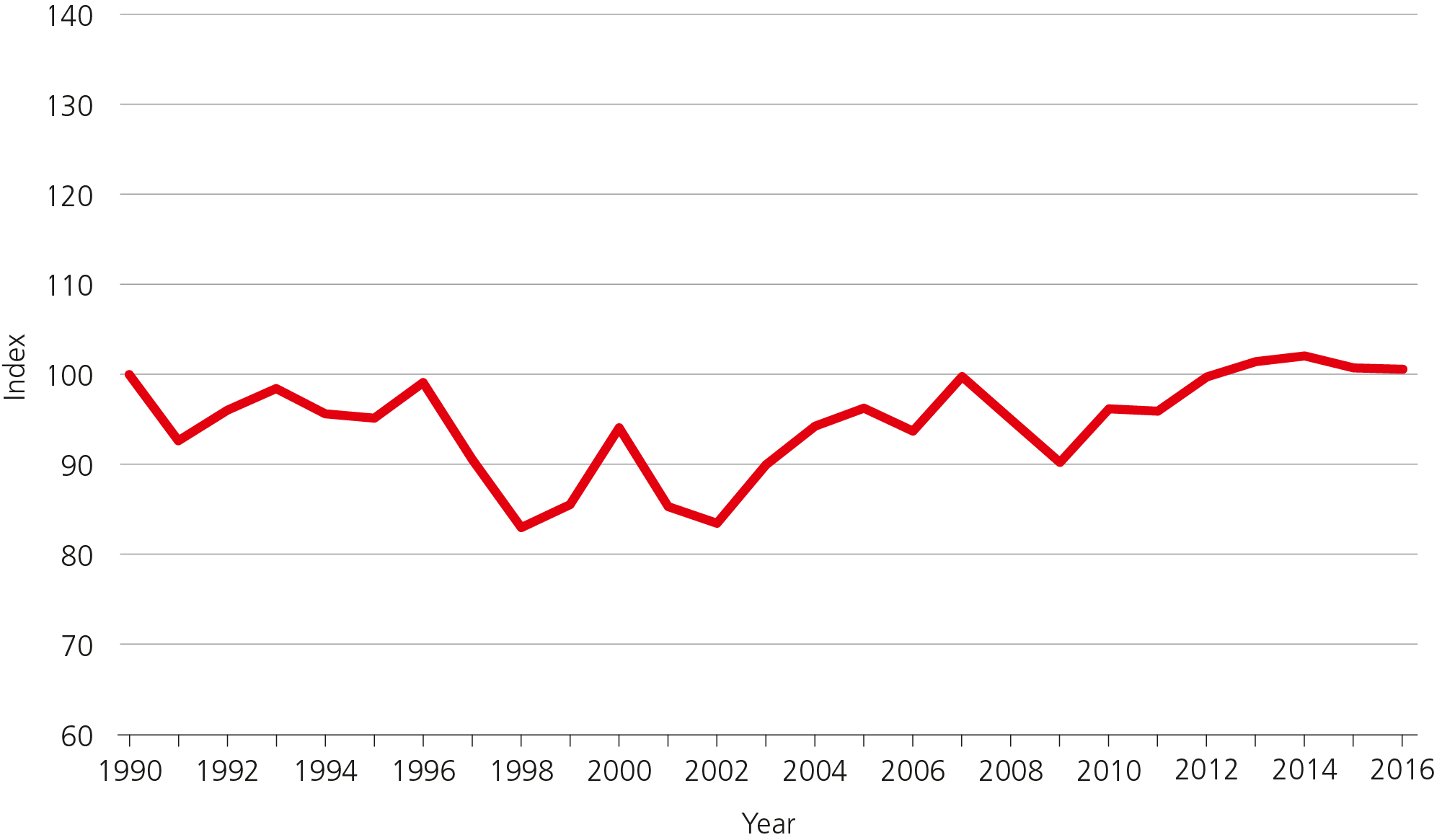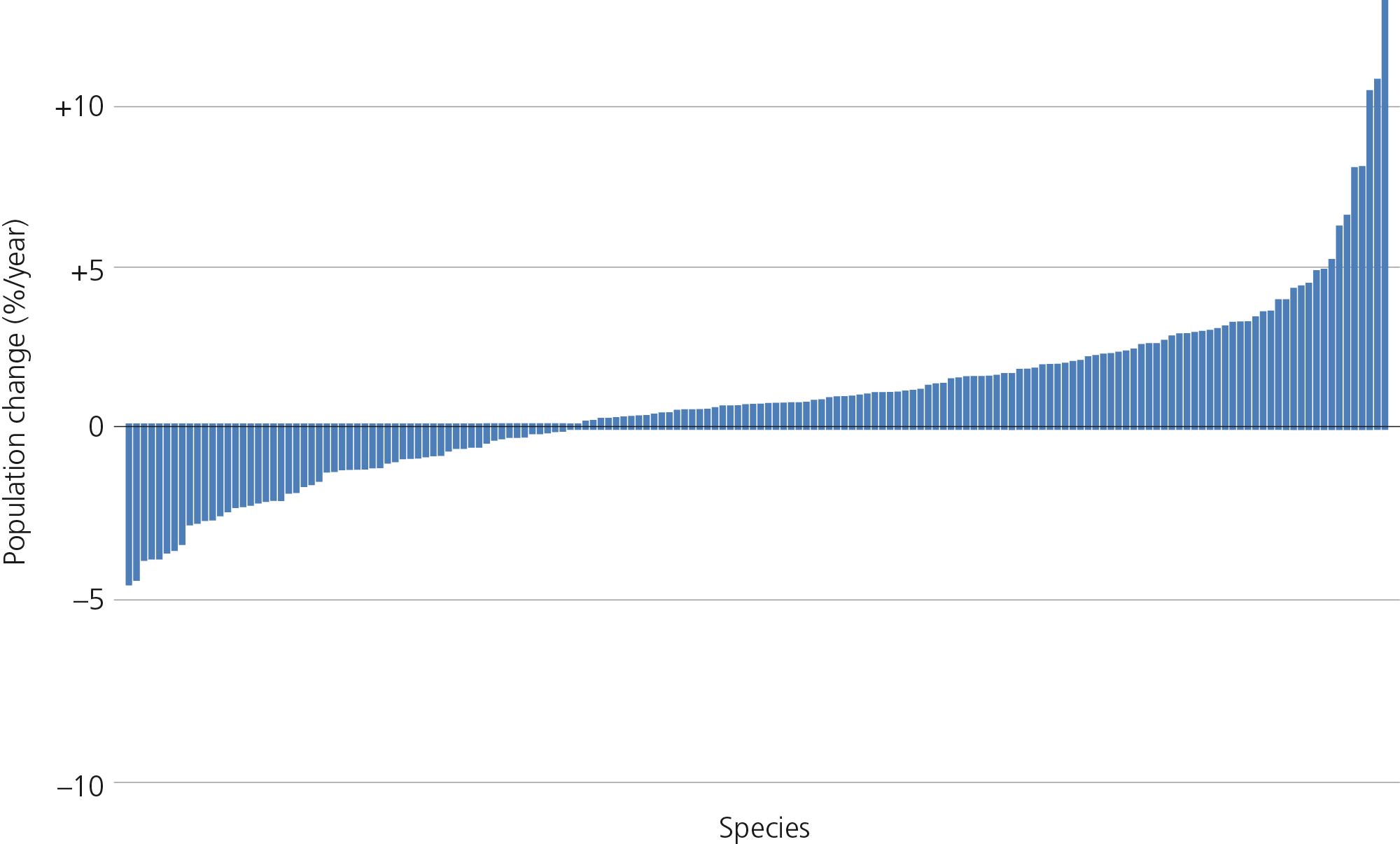Population trends

The combined breeding bird index for all 174 regular breeders (Swiss Bird Index SBI®) increased slightly between 1993–1996 and 2013–2016.
The population trends of the individual breeding bird species between 1993–1996 and 2013–2016 are largely positive. The Swiss Bird Index SBI® has also increased slightly since 1990.
Breeding bird indices are calculated for 174 regular breeders based on their population numbers since 1990. We used these indices to determine the relative change in breeding population sizes between 1993–1996 and 2013–2016. The positive trends outnumber the negative ones. In two thirds of species, numbers have increased, while one third have seen declines. About 40 % of all species show an increase in their breeding populations by more than 1 % per year; about 20 % decreased by more than 1 % per year. The median value of change per species is + 0.6 % per year.
Similarly, the Swiss Bird Index SBI®, which combines the individual breeding bird indices, increased slightly between the two atlas periods. Similarly, the total number of territories increased significantly between 1993–1996 and 2013–2016, driven in part by the positive trends of several species that were already abundant in 1993–1996.

Average annual change in the populations of regular breeders between 1993–1996 and 2013–2016. Each species is represented by a bar that specifies the average population change per year.
Differences compared to previous population estimates
For some species the population estimate given in this atlas is higher than the one specified in the 1993–1996 atlas, although the population has decreased according to the breeding bird index. Such discrepancies are related to methodological changes in the calculation of the breeding populations. Population numbers were last updated in 2013/2014, but much older estimates were used for many species. Improved methodological possibilities and the excellent body of data collected for the 2013–2016 atlas allow us to more accurately determine the size of breeding populations as well as the uncertainty of the estimate. In particular, the new methods enabled us to correct for imperfect detection (e.g. birds that were overlooked) and inaccessible sections of the survey area. Accordingly, the population estimates for several species were revised upwards. A direct comparison of the figures given in 1993–1996 and 2013–2016 should therefore be avoided, as it may result in an inaccurate impression of the development of breeding populations. The breeding bird index also depicted in the atlas for each species is a more accurate representation of the population trend.
Sattler, T., P. Knaus, H. Schmid & B. Volet (2017a): État de l’avifaune en Suisse. Rapport 2017. Station ornithologique suisse, Sempach.
Sattler, T., P. Knaus, H. Schmid & B. Volet (2017b): Situazione dell’avifauna in Svizzera. Rapporto 2017. Stazione ornitologica svizzera, Sempach.
Sattler, T., P. Knaus, H. Schmid & B. Volet (2017c): The state of birds in Switzerland. Report 2017. Swiss Ornithological Institute, Sempach.
Sattler, T., P. Knaus, H. Schmid & B. Volet (2017d): Zustand der Vogelwelt in der Schweiz. Bericht 2017. Schweizerische Vogelwarte, Sempach.
Zbinden, N., H. Schmid, M. Kéry & V. Keller (2005a): Swiss Bird Index SBI. Artweise und kombinierte Indices für die Beurteilung der Bestandsentwicklung von Brutvogelarten und Artengruppen in der Schweiz 1990-2003/Swiss Bird Index SBI. Indices spécifiques et combinés décrivant l'évolution des effectifs des oiseaux nicheurs et de groupes d'espèces en Suisse entre 1990 et 2003. Schweizerische Vogelwarte/Station ornithologique suisse, Sempach.
Zbinden, N., H. Schmid, M. Kéry & V. Keller (2005b): Swiss Bird Index SBI® - Kombinierte Indices für die Bestandsentwicklung von Artengruppen regelmässig brütender Vogelarten der Schweiz 1990-2004. Ornithol. Beob. 102: 283–291.
